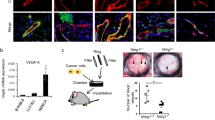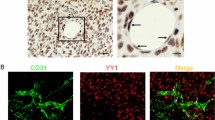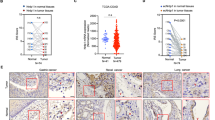Abstract
Prostaglandin E2 (PGE2), a major cyclooxygenase (COX) metabolite, plays important roles in tumor biology. We studied the role of EP2, a receptor for PGE2, in tumor angiogenesis using EP2 knockout mice. We found that deletion of the EP2 receptor impaired tumor angiogenesis and this finding was confirmed by an in vivo corneal angiogenesis model and an ex vivo aortic ring assay. To further characterize the cellular mechanisms of the EP2 receptor in angiogenesis, we isolated primary pulmonary endothelial cells (ECs) from wild-type (wt) and EP2−/− mice and observed that EP2−/− ECs exhibited defects in vascular branch formation when compared to wt ECs. In addition, EP2−/− ECs showed impaired cell motility on collagen-coated surface and they responded poorly to PGE2-induced cell migration compared to control cells. However, no difference in cell proliferation was observed between the EP2−/− and wt Ecs. In addition, EP2−/− ECs were more susceptible to apoptosis than wt cells under growth factor depletion conditions. Collectively, our data demonstrate that EP2 signaling in endothelium directly regulates tumor angiogenesis by contributing to cell survival and endothelial cell motility. Moreover, our finding suggests that EP2 is a major receptor in PGE2-mediated cell motility in ECs.
This is a preview of subscription content, access via your institution
Access options
Subscribe to this journal
Receive 50 print issues and online access
$259.00 per year
only $5.18 per issue
Buy this article
- Purchase on Springer Link
- Instant access to full article PDF
Prices may be subject to local taxes which are calculated during checkout







Similar content being viewed by others
References
Amano H, Hayashi I, Endo H, Kitasato H, Yamashina S, Maruyama T et al. (2003). J Exp Med 197: 221–232.
Bradbury D, Clarke D, Seedhouse C, Corbett L, Stocks J, Knox A . (2005). J Biol Chem 280: 29993–30000.
Breyer RM, Bagdassarian CK, Myers SA, Breyer MD . (2001). Annu Rev Pharmacol Toxicol 41: 661–690.
Chang SH, Liu CH, Conway R, Han DK, Nithipatikom K, Trifan OC et al. (2004). Proc Natl Acad Sci USA 101: 591–596.
Chang SH, Liu CH, Wu MT, Hla T . (2005). Prostaglandins Other Lipid Mediat 76: 48–58.
Dormond O, Bezzi M, Mariotti A, Ruegg C . (2002). J Biol Chem 277: 45838–45846.
Dormond O, Foletti A, Paroz C, Ruegg C . (2001). Nat Med 7: 1041–1047.
DuBois RN, Abramson SB, Crofford L, Gupta RA, Simon LS, Van De Putte LBA et al. (1998). FASEB J 12: 1063–1073.
Eberhart CE, Coffey RJ, Radhika A, Giardiello FM, Ferrenbach S, DuBois RN . (1994). Gastroenterology 107: 1183–1188.
Elder DJ, Halton DE, Playle LC, Parskeva C . (2002). Int J Cancer 99: 323–327.
Hernandez GL, Volpert OV, Iniguez MA, Lorenzo E, Martinez-martinez S, Grau R et al. (2001). J Exp Med 193: 607–620.
Hida T, Yatabe Y, Achiwa H, Muramatsu H, Kozaki K, Nakamura S et al. (1998). Cancer Res 58: 3761–3764.
Huang L, Sankar S, Lin C, Kontos CD, Schroff AD, Cha EH et al. (1999). J Biol Chem 274: 38183–38188.
Husain SS, Szabo IL, Pai R, Sorenghan B, Jones MK, Tarnawski AS . (2001). Life Sci 69: 3045–3054.
Jiang H, Weyrich AS, Zimmerman GA, Mcintyre TM . (2004). J Biol Chem 279: 55905–55913.
Kargman SL, O’Neill GP, Vickers PJ, Evans JF, Mancini JA, Jothy S . (1995). Cancer Res 55: 2556–2559.
Kennedy CR, Zhang Y, Brandon S, Guan Y, Coffee K, Funk CD et al. (1999). Nat Med 5: 217–220.
Kerbel RS . (2000). Carcinogenesis 21: 505–515.
Klagsbrun M, Moses MA . (1999). Chem Biol 6: R217–R224.
Kuwano T, Nakao S, Yamamoto H, Tsuneyoshi M, Yamamoto T, Kuwano M et al. (2004). FASEB J 18: 300–310.
Lin P, Polerini P, Dewhirst M, Shan S, Rao PS, Peters K . (1997). J Clin Invest 100: 2072–2078.
Mutoh M, Wwtanabe K, Kitamura T, Shoji Y, Takahashi M, KawamoriI T et al. (2002). Cancer Res 62: 28–32.
Narumiya S, Sugimoto Y, Ushikubi F . (1999). Physiol Rev 79: 1193–1226.
Pozzi A, Moberg PE, Miles LA, Wagner S, Soloway P, Gardner HA . (2000). Proc Natl Acad Sci USA 97: 2202–2207.
Rozic JG, Chakraborty C, Lala PK . (2001). Int J Cancer 93: 497–506.
Sano H, Kawahito Y, Wilder RL, Hashiramoto A, Mukai S, Asai K et al. (1995). Cancer Res 55: 3785–3789.
Seno H, Oshima M, Ishikawa TO, Oshima H, Takaku K, Chiba T et al. (2002). Cancer Res 62: 506–511.
Sonoshita M, Takaku K, Sasaki N, Sugimoto Y, Ushikubi F, Narumiya S et al. (2001). Nat Med 7: 1048–1051.
Tilley SL, Coffman TM, Koller BH . (2001). J Clin Invest 108: 15–23.
Tsujii M, Kawano S, Tsuji S, Sawaoka H, Hori M, DuBois RN . (1998). Cell 93: 705–716.
Watanabe K, Kawamori T, Nakatsugi S, Ohta T, Ohuchida S, Yamamoto H et al. (1999). Cancer Res 59: 5093–5096.
Williams CS, Mann M, DuBois RN . (1999). Oncogene 18: 7908–7916.
Yancopoulos GD, Davis S, Gale NW, Rudge JS, Wiegand SJ, Holash J . (2000). Nature 407: 242–248.
Yang L, Yamagata N, Yadav R, Brandon S, Courtney RL, Morrow JD et al. (2003). J Clin Invest 111: 727–735.
Acknowledgements
This work was supported in part by the following grants (NS45888 and CA108856) from National Institute of Health, and by the Vanderbilt-Ingram Cancer Center (CA68485).We thank Drs Raymond DuBois, Larry Marnett and Dennis Hallahan at Vanderbilt University Medical Center for their critical reading and comments on the manuscript. We thank Vanderbilt Cardiovascular Medicine Histo/Imaging Core for Technique support.
Author information
Authors and Affiliations
Corresponding author
Rights and permissions
About this article
Cite this article
Kamiyama, M., Pozzi, A., Yang, L. et al. EP2, a receptor for PGE2, regulates tumor angiogenesis through direct effects on endothelial cell motility and survival. Oncogene 25, 7019–7028 (2006). https://doi.org/10.1038/sj.onc.1209694
Received:
Revised:
Accepted:
Published:
Issue Date:
DOI: https://doi.org/10.1038/sj.onc.1209694
Keywords
This article is cited by
-
LimeMap: a comprehensive map of lipid mediator metabolic pathways
npj Systems Biology and Applications (2021)
-
Prostaglandin E2 breaks down pericyte–endothelial cell interaction via EP1 and EP4-dependent downregulation of pericyte N-cadherin, connexin-43, and R-Ras
Scientific Reports (2020)
-
Triumph and tumult of matrix metalloproteinases and their crosstalk with eicosanoids in cancer
Cancer and Metastasis Reviews (2018)
-
Eicosanoids and HB-EGF/EGFR in cancer
Cancer and Metastasis Reviews (2018)
-
Role of prostaglandins in tumor microenvironment
Cancer and Metastasis Reviews (2018)



